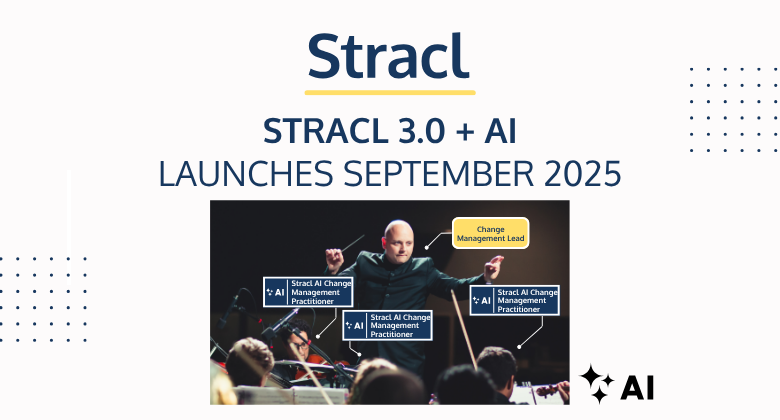Insights
This is a guide to create an effective stakeholder analysis at a fundamental level and how to conduct the process with the help of Stracl.

This guide will explain the five simple steps Stracl SaaS follows to conduct an effective stakeholder analysis, which includes:
Change is a constant factor in any business and managing that change efficiently should be every business’ goal. To achieve an efficient and smooth transformation (change from the current state to the future state) information must be collected to ensure that the expectations and concerns of those individuals or groups most affected by that change are addressed.
There are many definitions of stakeholders, driven by various professions like project or change management. For example, the ACMP (Association of Change Management Professionals) defines a stakeholder as: An individual affected by a change. Whereas PMI (Project Management Institute) defines it somewhat differently as: An individual or group affected by a change.
Regardless of what definition you use, it is critical that affected individuals or groups be taken into consideration. Their expectations and concerns that will affect a change’s trajectory
The purpose of a stakeholder analysis is to: To identify stakeholder attributes, like level of influence, commitment, or roles, and determine the size, scope, and complexity of the change’s impact on key individuals and groups. (Source: ACMP Standard for Change Management).
Without a basic understanding of your stakeholders, you will be unable to effectively engage, communicate to or train them in what is expected of them to accomplish your organization’s transformation.
Project managers and change managers all do stakeholder analysis. However, project managers who are affiliated with the PMI (Project Management Institute) may call it a stakeholder registry. Stakeholder analysis is a process used to identify individuals or groups who are impacted by a project, program, or organizational change. This involves identifying leaders, managers, employees, and others who will be impacted by a change initiative. They may be organized into groups. Once these individuals or groups are identified, data can be collected in order to address their needs and expectations. Their attributes, characteristics, qualities or traits are collected next. Such things as level of influence, interest, commitment, or roles are associated with the individuals or groups.
A well-executed stakeholder analysis will document and determine each stakeholder's attributes, so you can effectively plan on how best to manage their engagement and adoption of the change.

1. Agree on an approach and the information to be collected
Before starting a stakeholder analysis, the approach and detail needs to be agreed upon.
You must answer and inform your team of the answers to the following questions:
The selections you make for each of these decisions will have an impact on your time and your productivity. So, it is important to think carefully, especially if you are managing a large group of people who are doing the stakeholder analysis. You must make sure you have a consistent approach to collecting the information.
2. Identify stakeholders
Find which stakeholders will hold the most influence over and be the most affected by a project, program or transformation change. After this, you will find other departments and/or persons who must also be taken into account in varying degrees.
3. Prioritize stakeholders' importance and influence (power/Interest grid)
You can input these departments and individuals in a grid that best serves to show where they fall in terms of influence over the change.
Not all organizations follow a power interest grid operation in their stakeholder analysis, but they do know enough to determine which individuals and departments to focus on. The grid, however, serves as an effective visual aid to keep in mind.
Depending on the size of the organization, the depth in which stakeholders are to be surveyed will have to be agreed upon before setting out. In this regard, there are three levels of detail that can be considered: basic, standard and complex. From here one can determine which stakeholders require the least amount of information to be gathered on, and which ones will require a more complex survey. This will determine where the individuals and/or departments land on the power/interest grid.
There are many different names that are used in a grid to determine the level of importance each group can be assigned to, but the operation remains the same.
.png)

4. Execute stakeholder analysis
After ranking your stakeholders and determining their needs and expectations for the project, you can then begin plans for engaging them. You can do this through surveys, interviews, focus groups etc. Anything to gather the necessary data to proceed with the project.

5. Develop stakeholder engagement strategy and plan
Finally, now that you’ve considered everything you need to, it’s time to design your plan for how you will engage all your stakeholders, appropriately based upon their role in your change.
We’ll talk more about stakeholder engagement in future articles.
A stakeholder analysis can aid a project team in determining the most time efficient, cost friendly approach to implementing a change with minimal disturbance to business operations. The stakeholders hold influence over how smoothly a change transition occurs and by taking into account their concerns and expectations, change can be implemented easily.
Blog and Events
.png)
September 26, 2025
Releases
Stracl Inc launches Stracl SaaS 3.0, the next major evolution of its enterprise change management platform.
.png)
August 20, 2025
Releases
Stracl AI Connection Kit gives you everything you need to securely link any MCP-compatible AI.

July 30, 2025
News
Stracl Inc. is preparing to launch Stracl SaaS 3.0 + AI, the next major evolution of its enterprise change management platform.